22.12.2021
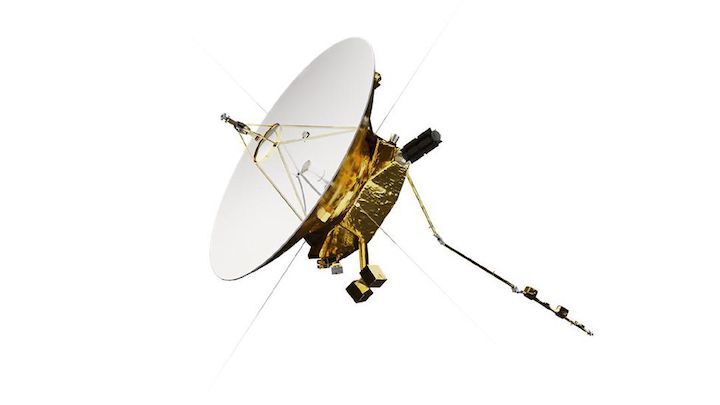
Imagine working on a project you know you have no hope of seeing through to completion. Would you have the motivation to even get it going?
Absolutely, says Ralph McNutt from Johns Hopkins University Applied Physics Laboratory (JHU-APL) in the US.
McNutt, with colleagues, has just published a detailed report that envisions a long-lived interstellar probe - a mission to the space between the stars.
Nasa's legendary Voyagers are travelling through this domain right now, but McNutt's probe would go further and faster and would expect still to be working 50-100 years after leaving Earth.
"Suppose this thing launched in 2036, and it got to the end of the nominal mission in 2086," he pondered. "That puts me at about 130 years old. I'm not going to worry about it. You have to hand these things off. I say to people, 'if you're into instant gratification, do not get involved with space exploration'."
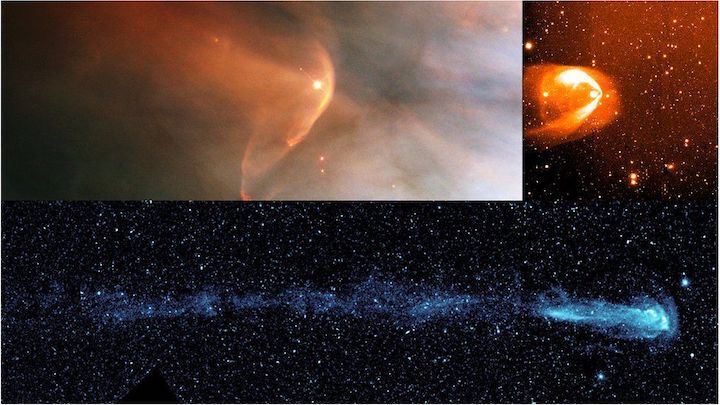
Voyagers 1 and 2 made history in the 2010s when they left the bubble of hot gas that surrounds our Sun, its so-called heliosphere, and entered the interstellar medium - the region of space dominated by the particles, dust and magnetic fields generated by other stars.
Today, more than 40 years after setting out on their grand adventure, these sentinels have traversed, in the case of Voyager 1, some 23 billion km; or 155 times the Sun-Earth distance, a separation scientists refer to as the Astronomical Unit to keep the numbers manageable.
The Voyagers have told us new things about the galactic environment in which our Sun lives, but that wasn't their primary goal. They were originally conceived to survey the outer planets - Jupiter, Saturn, Neptune and Uranus - which they completed in spectacular fashion. Their late career move was just a bonus.
McNutt's team wants to reverse the priorities.
"The Voyagers had instruments on board that were tailored to the exploration of planets. They did not have the dedicated instrumentation to really understand processes at the edge of the heliosphere," said JHU-APL's Elena Provornikova. The proposed interstellar probe would be built from the bottom up to deliver the desired science, she added.
To be clear, this is not a mission to another star. The nearest star systems are too far away for an operational probe to reach with current technology. But the spacecraft would be an enduring traveller in the gap between the stars.
The new study, initiated at the behest of Nasa's heliophysics division, is described as a deep dive on the engineering required and runs to almost 500 pages.
The working concept is an 850kg spacecraft, equipped with sensors to measure parameters such as charged and neutral particles, magnetic fields and dust.
The probe would be launched around 2036 on a super-heavy-lift rocket with additional stages to give it a thumping escape velocity.
The spacecraft would take a mere 6.5 hours to pass the orbit of the Moon and reach Jupiter in seven months for a sling-shot manoeuvre that pumped it up to a peak speed of six-to-seven astronomical units per year. That's over a billion km every 12 months.
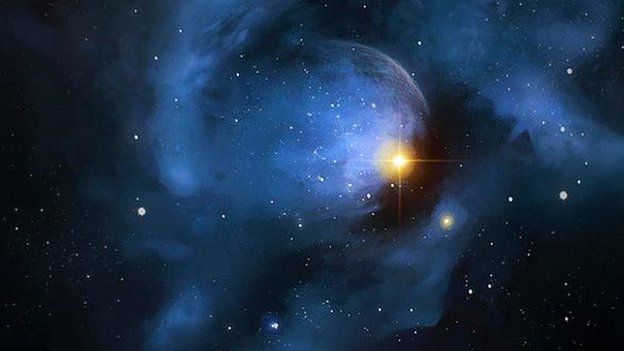
But it's also longevity that matters. The Voyagers are now prioritising instruments because their radioisotope thermoelectric generators have become so weak. But with two next-generation nuclear batteries now under development with Nasa, it's expected the interstellar probe could still be sending data back to Earth a century into an extended mission when it would be hundreds of AU away.
"What our study has done is take these dreams that the scientists have and put the engineering behind them," explained payload systems lead for the study team, Alice Cocoros.
"And we've come to the conclusion that with near-term technologies, technologies that won't need a whole lot of infusement or development, we can accomplish all the science we want to do with this mission concept, which is pretty exciting."
And when it came to it, if the funding agencies were so minded the probe could still include a flyby of an interesting object on its way out of the Solar System. Perhaps another pass of Pluto which we saw for the first time with the New Horizons mission in 2015, or maybe a rendezvous with one of those icy cousins that share the same far-flung orbit around the Sun.
But there's more than enough investigation to be done beyond the heliosphere. The Voyagers' data has piqued many new questions about the nature of our Sun's bubble, says project scientist Pontus Brandt.
"Four-point-six billion years ago, our Solar System started to take form, and with it this magnetic bubble which shields us from all the dust and plasma that we plough through on our journey through the galaxy.
"Having this interstellar probe will allow us to not only understand the current state but also understand where we come from, and how this has affected evolution; and where we're going next. Not many people know but we are about to exit our local interstellar cloud that this heliosphere has been ploughing through for the last 60,000 years. We're entering a completely new region."
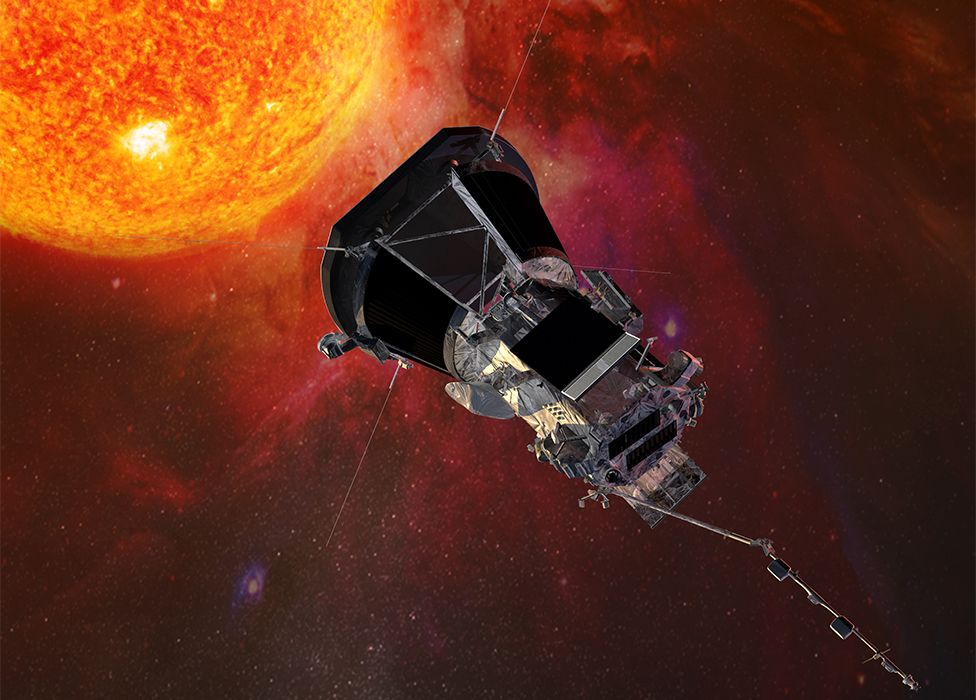 IMAGE SOURCE, NASA-JHU-APL
IMAGE SOURCE, NASA-JHU-APLWhether the interstellar probe gets the funding it needs to get off the ground (about $1.6bn; £1.2bn) will depend on the wider support of the solar and space physics community in the US and what they consider to be the most pressing research topics in their field.
They may think the money would be better spent on projects investigating the Sun's influence closer to home. Right now, with the Parker Solar Probe, they're enjoying the delights of flying through the Sun's outer atmosphere, a mere 8 million km from the star's surface, or photosphere - the very place from where everything that fills the heliosphere originates.
And it should be said, there are other concepts out there. China has a proposition it's working on called Interstellar Express. And the Russian-Israeli entrepreneur Yuri Milner has proposed Breakthrough Starshot, a private venture to send a fleet of tiny "StarChips" in the direction of the nearest star system.
"There are two things that really inspire people," said Pontus Brandt.
"One is obviously 'to boldly go where no-one has gone before', but the other aspect is the beauty of a long mission, where you do it for your future generations because inevitably that is where space exploration is going to take us. We do this for the future generations."
The JHU-APL team discussed its report at the American Geophysical Union Fall Meeting in New Orleans.
Quelle: BBC
----
Update: 19.01.2022
.
INTERSTELLAR PROBE PROPOSED TO EXPLORE THE SOLAR NEIGHBORHOOD
A unique mission concept known as Interstellar Probe would venture beyond the solar system and probe our neighborhood environment.
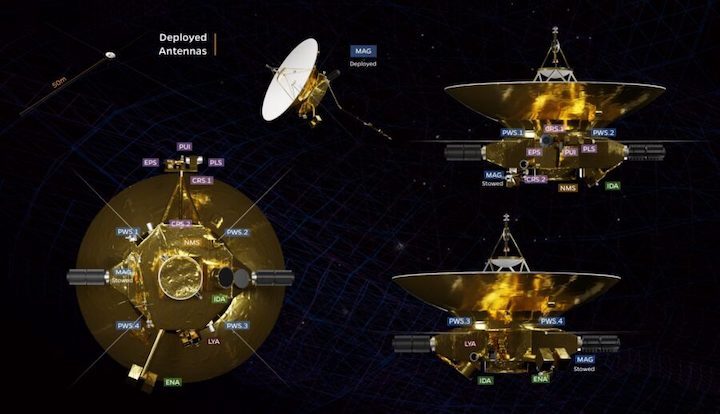
An exciting mission spanning the next half century of space exploration may leave Earth on a path out of the solar system in the next decade. Researchers from the Johns Hopkins University Applied Physics Laboratory revealed a formal proposal for the Interstellar Probe at the American Geophysical Union meeting held in New Orleans, Louisiana at the end of 2021. The mission would give us a big-picture view of the Sun's neighborhood.
The Interstellar Probe, which could be part of the upcoming 2023–2032 Solar and Space Physics Decadal Survey that identifies the community's funding priorities, would be the first spacecraft to explicitly designed to probe the interface of the Sun's protective bubble, known as the heliosphere, and the rarefied gas around the Sun, the local interstellar medium. Such observations are only possible from beyond the influence of the solar system. Plus, the mission might visit a few interesting destinations along the way.
THE PATH OUT OF THE SOLAR SYSTEM
The proposal would see the Interstellar Probe mission launching on a Space Launch System (SLS) Block 2 heavy rocket in the mid-2030s. (The inaugural launch of the SLS-1 Block 1 is set to launch this year on March 12th on the Artemis 1 mission.)
To reach a range of 380 astronomical units (a.u.) from the Sun within 50 years, the mission will need to be a fast one: Interstellar Probe will need to leave Earth at up to 60,000 kilometers (over 37,000 miles) per hour, departing the Earth-Moon system faster than New Horizons did in 2006.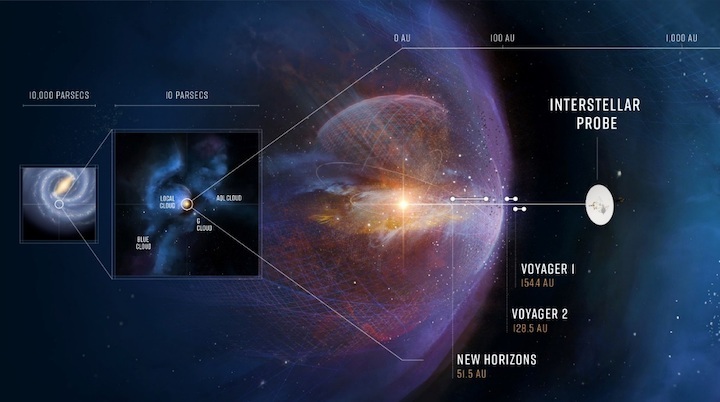
This graphic gives context to Interstellar Probe's voyage out of the solar system. The probe's ultimate goal is shown relative to the current positions of other far-flung missions.
Johns Hopkins APL
The spacecraft will likely make a passive or powered gravitational assist flyby past Jupiter to pick up speed. A Jupiter-assist launch window opens once every 13 months, setting constraints on when the probe can launch.
Ironically, an earlier proposed approach to accelerate the probe would have involved what’s known as an Oberth maneuver, which would send the probe on a blistering pass just under half a million miles from the surface of the Sun. That would set up a gravitational slingshot to fling the probe out of the solar system.
That trajectory would have involved several firsts, including the closest pass near the Sun, the fastest speed ever achieved — not to mention the first use of an Oberth maneuver by a spacecraft. It would also have required the addition of a massive sunshield. Ultimately, the team decided against this approach.
“The Oberth maneuver adds little speed in comparison with a Jupiter gravity assist, but poses a high mission risk,” says Cocoros. “Additionally, the Jupiter gravity assist option puts us in a sweet spot in terms of speed to do the science the community has identified as critical.”
Moving at an unprecedented speed, Interstellar Probe could reach the termination shock, at 90 a.u., in just 12 years. The mission's 50-year extended mission could span hundreds of a.u. past the heliopause, deep into the interstellar medium. Its lifetime would span nearly five 11-year cycles of solar magnetic activity.
Though Interstellar Probe builds on the legacy of other spacecraft that have or will escape the solar system, including Pioneers 10 and 11, New Horizons, and Voyagers 1 and 2, Interstellar Probe will be the first mission specifically be designed to probe the outer solar environment and the local interstellar medium.
“The beauty of the Interstellar Probe is not in reaching any one point but the journey it will take through the solar system,” says Alice Cocoros (Johns Hopkins APL). “We will begin taking measurements shortly after launching and will continue doing so for the duration of the 50-year mission . . . far beyond the reach of any spacecraft that has flown before. The continuity of these measurements throughout the journey will provide insightful information to answer some of the most pressing questions in space physics.”
SCIENCE OBJECTIVES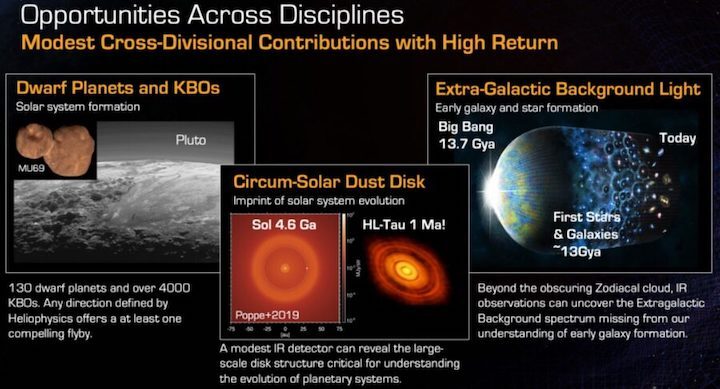
The goal of Interstellar Probe is to understand and characterize our protective bubble and its place in the environment around it. But as long as we’re sending a once-in-a-generation mission out of the solar system, it makes sense to carry out as much science as possible along the way. To this end, the mission will have several objectives.
The mission's primary goal is to understand the process shaping the heliosphere relative to the local interstellar environment, including the effects of the solar cycle. Researchers want to quantify the properties of the gas and dust around the Sun. They also want to measure the bowshock created as the solar system moves through the interstellar medium; the Voyagers passed through this boundary but produced more questions than they answered. Unlike the Voyagers, this mission would carry instruments to investigate particles of all sorts inside, along, and outside this boundary, including ionized plasma, dust, neutral atoms, energetic particles, and cosmic rays.
Critically, a launch in the late 2030s would allow the spacecraft to exit the solar heliosphere close to the “ram direction” into the interstellar wind, while also placing the mission far enough to the side to see the heliosphere's global structure via detections of energetic neutral atoms. The latter observations could settle the ongoing debate on where the heliosphere is shaped more like a crescent or more like a tadpole, with a tail trailing in the Sun's wake.
Farther out, the mission will seek to understand our solar system’s current position amongst several local interstellar "clouds." These clouds are regions of the interstellar medium that have slightly more dust and gas (though they're still more rarefied than the best vacuum on Earth).
Nevertheless, the clouds, as well as pressure from nearby supernovae, affect the size and shape of the heliosphere, at times squeezing it inward enough to remove some of its protection. The Sun has been traversing one cloud, unimaginatively named the Local Interstellar Cloud, for the last 60,000 years, but it may be on the edge. The solar system is expected to exit this cloud in just 2,000 years, and it may already be in contact with the next one. The spacecraft would use four 50-meter radio antennas to measure plasma electron density to understand our place among these clouds. Understanding their effect on cosmic ray flux is crucial to understanding their impact on the evolution of life on Earth.
“Our heliosphere is the only habitable astrosphere we know today,” says Elena Provornikova (Johns Hopkins APL). “How it is formed, how it evolved in the past and will evolve in the future during its travel in the galaxy, how this evolution affects atmospheric and surface habitability of the planets is yet to be discovered with the Interstellar Probe mission.”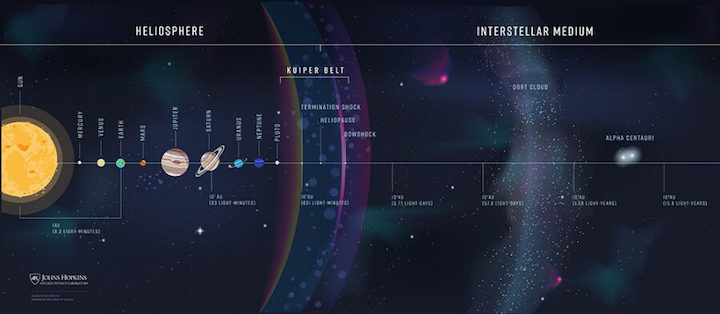
This infographic shows the layout of the solar system, the heliosphere, and beyond on a log scale, with distances increasing logarithmically to the right.
Johns Hopkins APL
In addition to this broad primary goal is the supporting objective of exploring Kuiper belt objects while en route in an effort to understand planetary origins. The initial report lists 10 flyby candidates, including 50000 Quaoar, 225088 Gonggong, and 90482 Orcus.
How many objects the probe can reach depends on when it launches. For example, a 2040 launch would put it on a trajectory to fly past Quaoar, a distant world that seems to be rapidly losing volatiles. That flyby window would also send the mission toward a vast ribbon of energetic neutral atoms streaming across the boundary of the heliosphere, as seen by NASA’s Interstellar Boundary Explorer (IBEX) in 2013. The probe could provide views complementary to those of IBEX and the Interstellar Mapping Acceleration Probe (IMAP) from their positions at 1 a.u.
“A potential flyby of a small dwarf planet or an object in the Kuiper Belt will enable exploration of a world never visited before, and provide leaps in understanding the diversity of these bodies in the solar system,” says Provornikova
.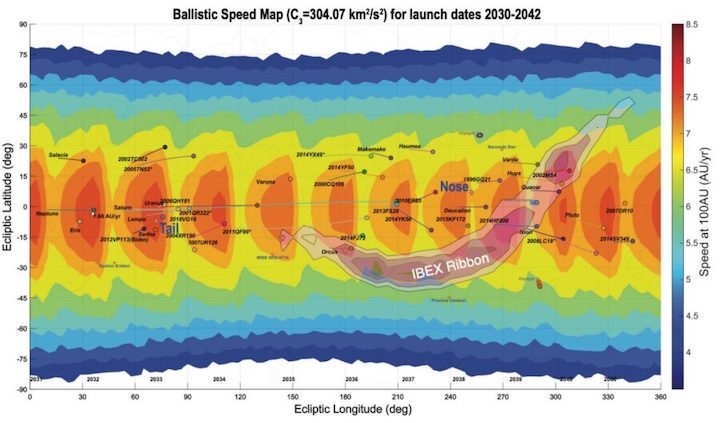
This plot shows possible launch windows for Interstellar Probe in the coming decade, highlighting potential flyby targets. The orange half-moon pattern arises from the 13-month cadence for a Jupiter gravity assist.
Johns Hopkins APL
A second supporting goal would see the Interstellar Probe performing astrophysics observations that can only be done outside of the solar system. One prime example is understanding galaxy and star formation via extragalactic background light. This diffuse light from unresolved stars and galaxies can only be seen beyond the obscuring effects of the zodiacal light, produced as dust in the inner solar system scatters sunlight. New Horizons has already made observations of this background on its outbound journey.
To support these goals, the mission would explore the inner heliosphere, between 1 and 90 a.u. during its first 12 years. Then it would enter the heliosheath, around 90 to 120 a.u. for the next four years, before entering the interstellar medium beyond about 120 a.u. The mission is expected to take 50 years to reach 380 a.u. from the Sun. For context, the most distant spacecraft (Voyager 1) is currently 155 a.u. distant. Voyager 2 (the most distant operational spacecraft) is 129 a.u. out. It will probably fall silent in a decade or so, passing the distinction to New Horizons, currently at 52 a.u..
MISSION DESIGN
The projected mission cost is $1.7 billion (projected in FY25 dollars, with cost from design through launch but not including rocket), with an additional $230 million per decade for operations.
Like other spacecraft escaping the solar system, the mission would incorporate a pair of next-generation plutonium-238-fueled Multi-Mission Radioisotope Thermoelectric Generators (MMRTG), which will provide decades of reliable power far from the Sun.
The mission will incorporate several instruments to measure properties of the outer solar system and the interstellar environment, but the final mission payloads will be dictated by the launch window and ensuing flybys. For communication, the probe will use the soon-to-be-upgraded Deep Space Network out to 70 a.u., before switching to the next-generation Very Large Array network, as outlined in the recent Astronomy and Astrophysics Decadal Survey, which should allow communication out to 1,000 a.u.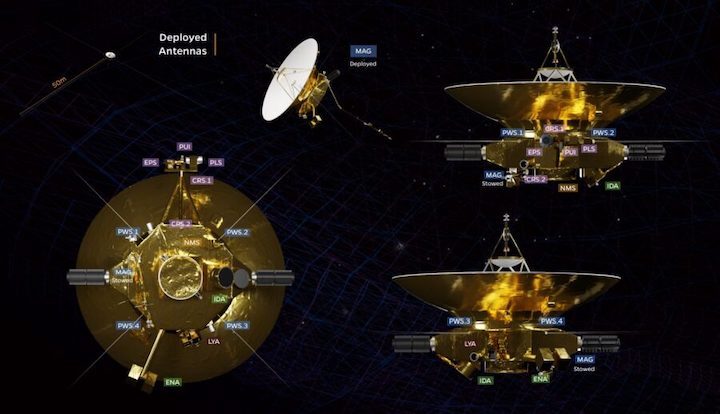
The next hurdle for the mission is the Solar and Space Physics Decadal Survey, due out next year, which could select Interstellar Probe as a flagship mission. China also has a plan for a similar Interstellar Express mission or set of missions, possibly launching as early as 2024.
How much has our local astrosphere shaped our local galactic environment, and our home in it? With the breathtaking scope of the Interstellar Probe mission, we may know by the end of the century.
Quelle: Sky&Telescope

